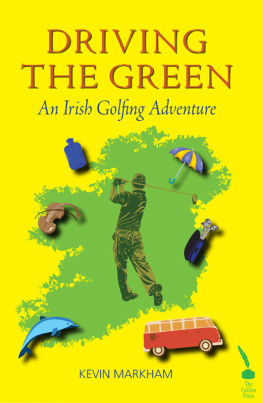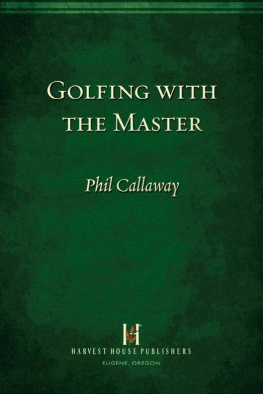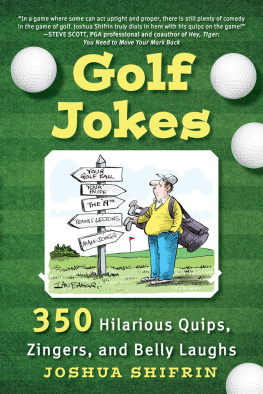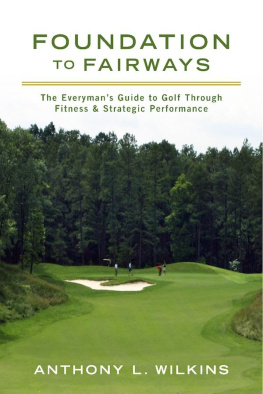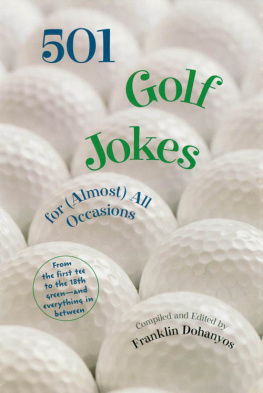




Kevin Markham started playing golf at the age of six and has played ever since. After ten years working in London and Dublin, he became a freelance copywriter and took the opportunity to play a lot more golf. Not for the better it turns out. He writes about golf for newspapers, magazines and blogs. His first book was Hooked An Amateurs Guide to the Golf Courses of Ireland (2011).
Kevin has an active online presence through his blog and social media. He also has over 7,000 golf course photographs on his Flickr page.
www.theirishgolfblog.com
www.flickr.com/photos/kevinmarkham
www.twitter.com/kevinmarkham
www.facebook.com/HookedOnIrishGolf

This book is dedicated to greenkeepers everywhere the men and women who slave over our courses, making our fairways play so beautifully and our greens run like silk. You are rarely seen and rarely given the respect you deserve for working in all kinds of weather so that we golfers can enjoy our game.
On my travels you appeared with breakfast (Raymond at Killymoon), located errant balls, retrieved golf clubs and took time to have a chat. Thank you although that does not extend to the greenkeeper who cost me my first hole-in-one!
CONTENTS
Ive got a feeling for the game of golf. I did very well on the course in Skegness, until I got stuck in one of the little wooden windmills.
RIGSBY, Rising Damp
Orange wellington boots. Not the obvious choice of footwear on a golf course, but I was only eight years old and Barley Coves nine-hole course was a minefield of cowpats. It was fortunate that my fashion imperatives and practical sensibilities combined so seamlessly. Over the years I have committed many crimes against fashion, but in those boots I rocked.
I had been playing golf for a few years, taught by my father and grandfather. Their hallowed golfing ground was Greystones Golf Club, but it wasnt somewhere an eight-year-old boy could get to easily. Barley Cove in County Cork, however, was a regular family summer destination and it had a links golf course right on the doorstep. On these summer holidays we would hire a chalet overlooking the beach and holes that stretched across the dunes. Most days I played it twice, getting up at the crack of dawn and sneaking out. On the first occasions when I disappeared into that early morning mist, my mother arose to find her son gone, probably kidnapped. My dad was booted out of bed to find me. And when he did, somehow hed managed to bring his clubs too.
Every morning, at that ridiculous hour, I would head off in my wellies with Granddads cut-down clubs, some old balls and the wild seaside air in my soul. The course was about as natural a creation as you could find. Fairways ran an obvious route between distinct dunes, with a tee at one end and a green at the other. It really was as simple as that. Barley Cove was crammed with the usual links hazards but the cowpats were extra special. Cows have little understanding of golf etiquette. Fairways, rough, tee boxes wherever a golf ball could go, you could be sure that a cow had already left its calling card. Except the greens. A holiday course it might have been, but even here the greens were sacred. They were enclosed by electric wire fencing and the cows never went near them. The wire ran all the way around the green at a height of about two feet. There was a gate that golfers would open and close, but sometimes when you were on the opposite side of the green you simply stepped over it. Two feet. It doesnt sound very high but for an eight-year-old boy, whose crotch happened to be at the exact same height as the electric wire, it was a severe obstacle.
I have always been told that you learn from your mistakes. The mistake I made that day, as my most sensitive parts made contact with a current strong enough to repel a 1,000-lb animal, has left me with a deep appreciation of the power and pain of electricity.

In 1998, married and in my thirties, I returned from eight years in London, and finally got back to golf. I played occasionally in the UK but it is almost impossible to get a regular game unless you are a member somewhere.
I fell in love with the game again and wanted to play as many courses as possible. Naturally, the big-name courses held most appeal but playing all of them was an unrealistic dream.
Has anyone heard of Newcastle West? Ronan asked as we sat in the Greystones clubhouse one day.
Three of us shook our heads, so the following Monday I went to Dublins Hodges Figgis bookshop and searched in the sports section for Newcastle West. There was next to nothing. The only reference I found was to a pleasant parkland with big trees. Greystones Golf Club was similarly dismissed with a one-line description.
That was wrong.
I started to have ideas for a golf book of my own a book that would review every Irish eighteen-hole golf course equally, from an amateurs perspective. It wouldnt dwell on history or the designer; it wouldnt pander to a course because of its reputation; and it would be about the golf experience, pure and simple.
The question was, how could I play every course without losing my house and, quite possibly, my wife? I mapped out potential routes and calculated how many golf clubs Id have to visit. The number started at 326 (the official Golfing Union of Ireland figure), but I found another 23 along the way some as I was passing the gates.
There was also the matter of how much this was going to cost. If I stayed at B&Bs or hotels and ate out in clubhouses every day, it was going to cost in the region of 15,000. It was not a figure I could justify and reality stamped on my enthusiasm.
Get a camper van, my wife suggested. You can always sell it afterwards.
I returned to the maps, back on plan. Now I had to figure out how best to approach golf clubs to ask them if I could play their course. The main goal was not to pay a green fee. Yes, I know this sounds cheap, but consider the alternative: if you work on an average green fee of 50, multiply that by 349, you end up with over 17,000. I decided the easiest thing to do would be to seek the advice of Royal County Down, a world-famous club with two links courses. I phoned up and asked what I should do. The voice at the other end of the phone said, Youll need to contact either the Northern Irish Tourist Board or Tourism Ireland and ask them to write to us on your behalf, requesting a round of golf and when you would like to play. We will contact them with our response and they will then contact you. In order to acknowledge our generosity you must bring your first born to be sacrificed to the golfing gods of the north.
I asked the obvious question: Is this to play both courses or just the Championship one?
Some courses were always going to be difficult to access: I had already played Royal County Down, Royal Portrush and The K Club, but I expected Old Head, Ballybunion, Lahinch, Doonbeg and Portmarnock to be problematic. As it turned out, only one of these proved awkward. In general, getting to play Irelands courses was an easy exercise. Perhaps that reflects the generous nature of Irish people and the way that fellow golfers are embraced on this island. I made a phone call, explained what I was doing and the manager, secretary, or professional went out of their way to accommodate me. A few requested an email to clarify things, but I was keeping a blog and I had a publisher behind me, which was usually more than enough to satisfy anyone who reckoned I was pulling a fast one. And those who still thought I was after a freebie only had to look at my camper van to realise that if that was the case, I was one sad and lonely individual.
Next page
